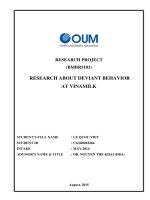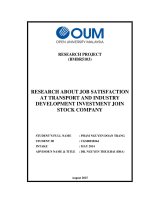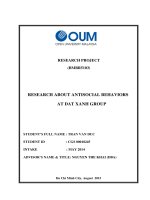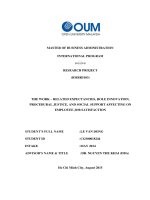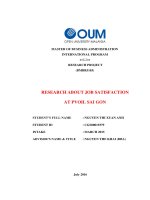Research about career commitment at saigon securities inc
Bạn đang xem bản rút gọn của tài liệu. Xem và tải ngay bản đầy đủ của tài liệu tại đây (1.04 MB, 64 trang )
RESEARCH PROJECT
(BMBR5103)
RESEARCH ABOUT CAREER COMMITMENT
AT SAIGON SECURITIES INC.
STUDENT’S FULL NAME
: HOANG MANH HUNG
STUDENT ID
: CGS00019896
INTAKE
: SEPTEMBER 2015
ADVISOR’S NAME & TITLE
: NGUYEN THE KHAI (DBA)
March 2017
Advisor’s assessment
..................................................................................................
..................................................................................................
..................................................................................................
..................................................................................................
..................................................................................................
..................................................................................................
..................................................................................................
..................................................................................................
..................................................................................................
ADVISOR’S SIGNATURE
NGUYEN THE KHAI (DBA)
ACKNOWLEDGEMENTS
The first word I would like to express my deepest gratitude to Dr. KHAI NGUYEN
(DBA), who instructed, gave me a chance and inspired me to do this research. I
also would like to express my thanks to my colleagues who helped me with very
useful information to do this assignment. Thanks all employees of Sai Gon
Securities Inc. for their precious comments and helps to collect data for this
research.
After studying at Hutech I have gained a lot of valuable knowledge from the
teacher to be able to complete this topic. I would like to thank administrators, the
teachers directly teach, mentor and impart to you is professional knowledge while
studying in the school.
And, I also specially thank to my members of family, friends and colleagues always
mobilize me to finish this research.
Thank you very much.
Hoang Manh Hung Student
Contents
ABSTRACT ..............................................................................................................1
PART 1. INTRODUCTION ....................................................................................2
About Sai Gon Securities Inc. ................................................................................2
Research problem statement.................................................................................10
Research objectives ..............................................................................................11
Scope of research..................................................................................................11
Significance of research .......................................................................................12
Limitation of research ..........................................................................................13
PART 2: LITERATURE REVIEW......................................................................13
Definition of Constructs .......................................................................................13
Argument for the relationship among the constructs ...........................................21
Previous Researches on career satisfaction ..........................................................28
Research Hypotheses and Research Model ..........................................................30
PART 3: METHODS .............................................................................................31
Data collection ......................................................................................................31
Data collection progress .......................................................................................37
Data analysis.........................................................................................................37
PART 4: ANALYSIS AND RESULTS ................................................................38
Cronbach’s Alpha .................................................................................................38
Descriptive information........................................................................................40
Hypotheses testing ................................................................................................42
PART 5: CONCLUSIONS ....................................................................................44
Discussion ............................................................................................................44
Limitation of research ..........................................................................................45
Forecast recommendation ....................................................................................45
REFERENCES .......................................................................................................47
APPENDIX .............................................................................................................49
Appendix 1: Survey ..............................................................................................49
Appendix 2: Presentation .....................................................................................55
Figure
Figure 1: Hackman and Oldham's Job Characteristics ..........................................22
Figure 2: McClelland’s theory .................................................................................23
Figure 3: Maslow’s theory .......................................................................................24
Figure 4: Alderfer’s ERG theory .............................................................................26
Figure 5: Herzberg’s two-factor theory...................................................................27
Figure 6: Research model of Career commitment ...................................................31
TABLE
Table 1: Career commitment Scale ..........................................................................32
Table 2: Work-Related Depression, Anxiety and Irritation .....................................33
Table 3: Performance Appraisal System Knowledge...............................................34
Table 4: Empowerment at Work Scale .....................................................................35
Table 5: Procedural Fairness ..................................................................................36
Table 6 : Time table for data collection progress ....................................................37
Table 7 : Cronbach’s Alpha - Internal Consistency ................................................38
Table 8: Cronbach’s Alpha of Career commitment .................................................39
Table 9: Cronbach’s Alpha of Work-Related Depression, Anxiety and Irritation ..39
Table 10: Cronbach’s Alpha of Performance Appraisal System Knowledge ..........39
Table 11: Cronbach’s Alpha of Empowerment at Work Scale ................................40
Table 12: Cronbach’s Alpha of Procedural Fairness..............................................40
Table 13: Descriptive Statistics................................................................................41
Table 14: Correlation statistics................................................................................42
Table 15: Model Summary .......................................................................................42
Table 16: Coefficients ..............................................................................................42
ABSTRACT
The purpose of this research is to determine the relationship between
variables in the model such as Performance Appraisal System Knowledge,
Empowerment at Work Scale, Procedural Fairness, Work-Related Depression,
Anxiety and Irritation with Career commitment. The research result was
conducted in Sai Gon Securities Inc. with 288 employees.
And SPSS software version 22 (copyright of IBM) is a tool that is
used to analysis data in this research. The collected data were analyzed through
factor analysis, Cronbach’s alpha, descriptive statistics, correlation, and multiple
regression analysis. The research showed that there are four factors influencing
Career
commitment
are
Performance
Appraisal
System
Knowledge,
Empowerment at Work Scale, Procedural Fairness, Work-Related Depression,
Anxiety and Irritation. Moreover, the research provides some recommendations
implications for managers to raise the level of satisfaction with work of the
employees.
Key word: Performance Appraisal System Knowledge (PAS),
Empowerment at Work Scale (EWS), Procedural Fairness (PF), Work-Related
Depression, Anxiety and Irritation (WAI), Career commitment (CC)
Page 1/59
PART 1. INTRODUCTION
About Sai Gon Securities Inc.
Saigon Securities Inc. (SSI) is a leading and reputable financial corporation in
Vietnamese market. With a sound financial potential, a large and professional
employees of the company, SSI always provides to all its customers the
outstanding level of products and services and maximizing shareholders' interest.
SSI has an extensive branch network in Vietnam at major cities such as Hanoi,
Ho Chi Minh City, Nha Trang, Vung Tau.
With a wide range of international standardized products and services for
institutional, individual, domestic and foreign customers. SSI has gained
credibility not only from local but also from global clients and partners. Some
outstanding clients from SSI are Morgan Stanley, HSBC, Vinamilk, Hoang Anh
Page 2/59
Gia Lai, Vietnam National Petrolium Group Petrolimex, Credit Suisse, BIDV,
ANZ, C.T Group, Prudential VN, Deutsche Bank...
1.1 History:
1999: SSI was founded with the head office based in Ho Chi Minh City,
and two main operations: Brokerage services & Investment Advisory.
2001: Chartered capital was raised to VND 20,000,000,000 with 4 main
operations as follows: Investment Advisory, Brokerage Services,
Principal Investment & Securities Depository
2002: SSI established its branch in Hanoi, expanding its networks to
Northern areas.
2005: SSI raised chartered capital to VND 52,000,000,000 with 6
services, Successful IPO advisor of VSH (Vinh Son – Song Hinh
Hydropower JSC) – It was the first hydropower company which IPO in
Vietnam Stock Market. It was also the first IPO with repo service.
2006: Chartered capital was raised to VND 300 billion, becoming the
largest capitalized securities firm on Vietnam stock market at the time.
2007: SSI was officially listed on Hochiminh Stock Exchange, Chartered
capital reached VND 799,999,170,000
2008: Successfully ran the largest stock issuance in 2008 for Hoang Anh
Gia Lai JSC (HAG), Chartered capital reached 1,366,666,710,000 VND.
2009: SSI Asset Management (SSIAM) and Daiwa SMBC Capital signed
the establishment agreement and jointly managed DSCAP - SSIAM
Page 3/59
Vietnam Growth Investment Fund LLC - the only foreign onshore fund in
Vietnam till now SSI was awarded the ―Best Broker in Vietnam‖ and the
―Best Equity House in Vietnam‖. These awards were presented by the
famous FinanceAsia for the second consecutive year.
2010: Chartered capital reached 3,511,117,420.000 VND, successfully
advised the first tender offer in Vietnam Securities Market between Hung
Vuong Fisheries JSC (HVG) and An Giang Fisheries Import & Export
JSC (AGF).
2011: SSI was honored to receive the Third Labor Medal for outstanding
achievements in construction and development the stock market in the
period of 2000 – 2010.
2013: Top 500 Vietnamese Largest Private Enterprises (VNR500)
2014: Top 50 Best Vietnamese Listed Companies 2014 (Forbes)
2015: Received certificates of Prime Minister, People's Committee of Ho
Chi Minh City.
1.2 Vision – Mission – Core values:
The Business of Success
SSI operates based on the vision ―The Business of Success‖.
At the heart of all their products and services is a drive for achieving success.
They help unlock opportunities in financial markets, and turn these into
prosperity and growth.
Mission: Connecting Capital to Opportunities
Page 4/59
SSI’s mission is to connect capital to opportunities.
This mission unifies all the businesses under the SSI brand and will guide any
future opportunities, which the brand may take on.
Core values
Solutions-Led: They are focused on the outcome of making their customers
successful, and they prioritize their individual needs over existing products or
processes.
Skilled: They are experts in their industry and in our markets, and will
continually enhance their professional skills to provide the highest standards of
service to their customers.
Inventive: They empower and encourage their people to find creative new ways
to bring success to SSI and its customers.
1.3 Business Units
Saigon Securities Inc. (SSI – HOSE) is a leading financial institution that
provides a comprehensive range of products and services, including Securities
Services, Investment Banking, Asset Management and Treasury
SECURITIES SERVICES
Products and Services for enabling investing in listed stocks and mutual
funds including: Opening of trading accounts, brokerage, advisory, cash
transactions, securities depository; consultancy and support for OTC
transactions, distribution of open-ended fund certificates, and distribution
of certificates of deposit and corporate bond.
Financial services: Margin financing, and cooperation with banks to
support securities trading.
Page 5/59
E-trading services: Web Trading, Pro Trading, Mobile Trading, Smart
Trading, Contact Center and SMS.
Research and Advisory: macro reports, investment advisory report, daily
call report, industry research report, company reports, stock valuation
reports, money market reports, fund flow reports, technical analysis
reports.
Corporate access: company visits to listed/unlisted companies, seminars
to introduce investment opportunities to Vietnam and international
investors.
INVESTMENT BANKING
Corporate financing advisory: business evaluation, corporate financing
restructuring, listing and Initial Public Offering (IPO) advisory.
Mergers and Acquisitions (M&A) advisory.
Advisory for capital raising in domestic and international capital market:
stock issuance and underwriting, bond and derivatives issuance via public
offering or private placement
TREASURY
Treasury management including investment and funding activities
through term-deposits trust accounts, bond repos, fixed income
instruments and other structured product transactions;
Bond services including brokerage, auctions and underwriting services.
Providing flexible structured products to optimize advantage in funding
needs as well as investment capital on the market with optimal interest
rates and with appropriate maturities.
SSI ASSET MANAGEMENT
Fund Management: capital mobilization and management for onshore and
offshore funds, including fund investing in unlisted companies, mutual
fund and ETF.
Page 6/59
Portfolio Management: Discretionary and Non-discretionary Portfolio
Management for domestic/international institutions as well as individual
customers, corporate clients and Private Wealth management.
Investment Advisory: for institutional and individual, domestic and
foreign customers
Strategy and asset allocation advisory.
1.4 Development Objectives and Strategy
With the goal to maintain its position as the leading financial institution in
Vietnam market and reach out to international markets, SSI will strive endlessly
for operational innovation as well as product diversification. Customers will
always be placed at the center with the Company’s commitment to a long term
partnership and cooperation for mutual development. Many technological
solutions will be provided to increase the utility for customers and investors. SSI
will also continue to focus on developing a high quality human resource team to
meet the rigorous market demands; create a working environment in which each
individual is given opportunities to explore and develop full potentials,
contributing the highest value for the Company. SSI will continue to tightly
control costs and manage risks in order to improve financial performance.
SSI believes that the combination of building a reputable brand and operating in
accordance with standards will help maximize shareholders’ value.
Objectives and strategy for business operations are set forth as follows:
Securities Services
Boosting brokerage market share growth - continuing to maintain the No. 1
position by market share in the over brokerage market.
Improving the quality of products and services - guaranteeing to meet customer
needs as well as to help customers improve the investment efficacy. Continuing
to improve the quality of online trading products
Expanding the retail distribution network
Page 7/59
Coordinating closely with the Asset Management division to provide financial
solutions meeting the needs of customers.
Investment Banking
Striving to maintain the leading position in the market through:
Providing comprehensive financial solutions to clients
Expanding the network of customers both in the country as well as abroad
Extending cooperation with leading financial institutions in the world
Treasury
Improving the quality of treasury management
Diversifying products to minimize risks while growing the Company’s assets
Strengthening participation in and seeking for investment opportunities in the
bond market
Developing derivative products
Investment
Focusing on investments that create competitive added values
Improving investment performance through diversification strategies
Achieving high risk-adjusted returns
Asset Management
Continuing to grow the total assets under management
Diversifying products to meet the various needs of investors
Providing customized financial investment solutions to meet and improve
performance for investors.
Page 8/59
1.5 Organizational structure
Page 9/59
Research problem statement
Recently years is the time when companies have more difficulties in business
operations. Vietnam's economy slowing growth, rising inflation, the real estate
crisis affecting the banking system. Government creates solutions to control
credit more closely, thereby affecting the cash flow to invest in the stock market.
Investors are also more cautious in putting their money into the stock market,
they withdraw money and invest in safer areas such as: gold or savings deposits.
During this period, the operations of the securities companies are affected, SSI is
also among them. The retention of good employees, especially senior
management positions is very difficult in the context of the company's revenue
decline, the cost of salaries for employees is not stable as before. Attractiveness
from competing companies or the attractiveness of other industries has strongly
influenced employee engagement with the company.
Director at Sai Gon Securities Inc. realized Career commitment is important
factor for SSI develop sustainably their human resource to help organization to
operate more efficient, produce quality of products and services, build brand
awareness, customer trust and loyalty… But, some factors such as Performance
Appraisal System Knowledge, Empowerment at Work Scale, Procedural
Fairness, Work-Related Depression, Anxiety and Irritation are problems for
human resource management at Sai Gon Securities Inc.
Page 10/59
Research objectives
The objective of this research topic to explore, analyze the factors affecting the
career satisfaction of employees working in SSI, simultaneous survey, analyze
the comments and evaluation of each employee. On that basis make comment on
the effectiveness evaluation work at the company as well as providing
recommendations and solutions to improve the operational efficiency of the
management humman resource at Sai Gon Securities Inc. . This study focused to
research and solves practical problems about Career commitment of employees
with SSI. Subjects of the study subjects are employee currently working for SSI
My research will focus 3 main factors:
- Firstly: search related information and try to define what meaning Career
commitment is of employees at SSI
- Secondly: design research model and test related factors to check influence
between factors to access strong / weak level of each factor in influence
progress.
- Thirdly: discussing and proposing recommendation to improve the
effectiveness and forecast the human resources management at SSI in the next
time.
Scope of research
The purpose of this research is career commitment and factors effect to it.
Consider perceptions of employees with career and suitability of employees to
the organization. The study was conducted at three locations are Ho Chi Minh,
Vung Tau and Hanoi Branch Office, which include 500 employees of SSI.
Page 11/59
Contents of this research are only including factors influencing to career
commitment at SSI; it does not have intention of re-structuring, changing and
replacing the employees.
Implementation period is from 1-Jan to 25-Jan 2017. In this study, the I used
quantitative methods to survey and assess the career satisfaction of employees
based on 5-point scale. I used a questionnaire as a tool to collect data and
information of the object. This questionnaire will be processed the data to make
the results of Career Satisfaction based on the scale was constructed. The
questionnaire is listed in the Appendix section.
Significance of research
This research will help us understand and are more aware of the importance of
career commitment. Since then the organization can establish a plan, policy
organizations to improve career commitment. That is the most important
significance in connecting employees with organization. It brings stability
development for organization. For employees in career commitment shown
satisfaction about the psychology of individuals with their career. From there
they can express themselves, develop skills, develop loyalty to the organization.
In addition, it also improves employee loyalty to the organization and further,
employees will be loyal to the company, contributed to the financial strength of
the companies increasingly stronger in the future.
Page 12/59
Limitation of research
This research will have some limitation because the limited number of
employees participating in the survey. Culture of branches in the company are
different, leading to the perception of individuals with different career.
This research only focuses related contents at SSI and also can be not
generalized for securities industry.
Besides, the survey respondents are more qualified and different perceptions
about Career Satisfaction as well as the contents of survey shall be more
grammatical errors because of English - Vietnamese translation progress, it may
cause confusion for the reader when they answer.
PART 2: LITERATURE REVIEW
Definition of Constructs
Career commitment (CC)
Career commitment is one important parts of organization commitment.
Therefore, in order to understand the concept of career commitment, we must
understand the organization commitment. Organization commitment was
defined as the relative strength of an individual’s identification with an
involvement in a particular organization (Porter and Smith, Note 4).
Career commitment can be considered one's attitude towards one's profession or
vocation, where career commitment involves the development of personal career
goals and an identification with and involvement in those goals, such that one is
Page 13/59
willing to exert effort in support of their career, congruent with its values (Blau
1985; Goulet and Singh 2002; Kalleberg and Berg 1987; Porter, Steers, Mowday
and Boulian 1974)
To understand the literature of career commitment is necessary to define some
terminology; career commitment had been defined as the strength of one’s
motivation to work in a chosen career role. This definition focuses on motivation
and goal’s achievement within a specific career field. The definition is based on
Colarelli (1990) and Hall (1971).
Performance Appraisal System Knowledge (PAS)
Performance appraisal may be defined as a structured and formal interaction
between a subordinate and supervisor, that usually takes the form of a periodic
interview (annual or semiannual), in which the work performance of the
subordinate is examined and discussed, with a view to identifying weaknesses
and strengths as well as opportunities for improvement and skills development.
In many organizations - but not all - appraisal results are used, either directly or
indirectly, to help determine reward outcomes. That is, the appraisal results are
used to identify the better performing employees who should get the majority of
available merit pay increases, bonuses, and promotions. Employee performance
reviews can be one of the best tools to boost performance, improve morale and
increase productivity. When done properly, performance evaluation is an
effective planning tool for managers and provides important feedback to
employees.
Page 14/59
For better performance of the organizations satisfied employees play a vital role.
Seldon, Ingraham & Jacobson, (2001) reported that more than 90 percent of
bigger organizations use performance appraisal system and more than 75 percent
are scheduled annually. Employee satisfaction is considered a key to
organizational success. Khan (2007) defines employee satisfaction with job as
how well ones personal expectations at work are in line with outcomes. Malik,
Bibi and Rahim (2010) state that people enjoy working, and strive to work in
those organizations that provide positive work environment where they feel they
are making difference and where most people in the organization are proficient
and pulling together to move the organization forward. The organizations in this
regard are struggling hard to keep their valued employees satisfied
Performance appraisal is frequently performed in organizations for a variety of
purposes, including administrative decisions (e.g., raise, promotion), feedback
and development, and personnel research. Thus, performance appraisals are
among the most important human resource systems in organizations insofar as
they represent critical decisions integral to a variety of human resource actions
and outcomes (Judge & Ferris, 1993). Because of its prevalence and importance
in organizations, performance appraisal is also one of the most widely
researched areas in industrial/organizational psychology (Murphy & Cleveland,
1995).
Of great concern to scientists and practitioners has been the issue of appraisal
effectiveness and its measurement. Appraisal effectiveness refers to how well
Page 15/59
the appraisal system is operating as a tool for the assessment of work
performance. It is perhaps best regarded as a multidimensional construct or an
ultimate criterion (Cascio, 1991) that cannot be directly measured but rather is
assessed through the measurement of other subordinate criteria (Cardy &
Dobbins, 1994). Cardy and Dobbins suggested that appraisal effectiveness is
composed of rater errors, rating accuracy, and qualitative aspects of the
appraisal.
Procedural Fairness (PF)
Procedural fairness refers to the perception by the individual that a particular
activity in which they are a participant is conducted fairly (Lind and Tyler
1988). Factors that contribute to perceptions of procedural fairness include
providing the consumer with voice, and control over actual outcomes (Folger
and Greenberg 1985, Lind and Tyler 1988). Research has shown that even if
outcomes are not favorable to an individual, individuals are less likely to be
dissatisfied with unfavorable outcomes if they believe that the procedures used
to derive those outcomes are fair (Lind and Tyler 1988, Greenberg 1987, Folger
and Bies 1989).
For consumer marketing, fair information practices operationalize procedural
fairness. Fair information practices are procedures that provide individuals with
control over the disclosure and subsequent use of their personal information.
They are global standards for the ethical use of personal information and are at
the heart of U.S. privacy laws, the privacy directive adopted by the European
Page 16/59
Union in July 1995, and the Clinton Administration's June 1995 guidelines for
personal information use by all National Information Infrastructure participants.
Empowerment at Work Scale (EWS)
Empowerment refers to measures designed to increase the degree of autonomy
and self-determination in people and in communities in order to enable them to
represent their interests in a responsible and self-determined way, acting on their
own authority. Empowerment as action refers both to the process of selfempowerment and to professional support of people, which enables them to
overcome their sense of powerlessness and lack of influence, and to recognize
and use their resources.
In the sphere of management and organizational theory, "empowerment" often
refers loosely to processes for giving subordinates (or workers generally) greater
discretion and resources: distributing control in order to better serve both
customers and the interests of employing organizations.
During the 1980s and 1990s, empowerment has become a point of interest in
management
concepts
and
business
administration.
In
this
context,
empowerment involves approaches that promise greater participation and
integration to the employee in order to cope with their tasks as independently as
possible and responsibly can. A strength-based approach known as
"empowerment circle" has become an instrument of organizational development.
Multidisciplinary empowerment teams aim for the development of quality
circles to improve the organizational culture, strengthening the motivation and
Page 17/59
the skills of employees. The target of subjective job satisfaction of employees is
pursued through flat hierarchies, participation in decisions, opening of creative
effort, a positive, appreciative team culture, self-evaluation, taking responsibility
(for results), more self-determination and constant further learning. The optimal
use of existing potential and abilities can supposedly be better reached by
satisfied and active workers. Here, knowledge management contributes
significantly to implement employee participation as a guiding principle, for
example through the creation of communities of practice.
However, it is important to ensure that the individual employee has the skills to
meet their allocated responsibilities and that the company's structure sets up the
right incentives for employees to reward their taking responsibilities. Otherwise
there is a danger of being overwhelmed or even becoming lethargic.
Work-Related Depression, Anxiety and Irritation (WAI)
Since the 1990's there is a change at many workplaces in industrialized
countries. Work related depression emerges as a major cause of long-term
sickness. The relationship between work and depression is bidirectional: work
gives acceptance and self-confidence to the individual but stress at the
workplace may precede depression. The relationship between work-related stress
and depressive disorders is shortly reviewed. The underestimated costs of lost
productivity by depression are so impressive that better preventional and
interventional strategies are necessary to reduce early disability payments and to
improve rehabilitation at the workplace.
Page 18/59
Depression is a state of low mood and aversion to activity that can affect a
person's thoughts, behavior, feelings, and sense of well-being. People with a
depressed mood can feel sad, anxious, empty, hopeless, helpless, worthless,
guilty, irritable, angry, ashamed, or restless. They may lose interest in activities
that were once pleasurable, experience loss of appetite or overeating, have
problems concentrating, remembering details or making decisions, experience
relationship difficulties and may contemplate, attempt or commit suicide.
Insomnia, excessive sleeping, fatigue, aches, pains, digestive problems, or
reduced energy may also be present.
Anxiety disorder describes a group of illnesses such as generalized anxiety
disorder, obsessive-compulsive disorder, panic disorder, post-traumatic stress
disorder, and phobias, there are some symptoms that characterize the illness as a
whole.
According to the American Psychiatric Association, when people suffering from
anxiety disorders talk about their condition, they often include these
descriptions:
o Unrealistic or excessive worry
o Exaggerated startled reactions
o Sleep disturbances
o Jitteriness
o Fatigue
o Dry mouth
Page 19/59
o Lump in throat
o Trembling
o Sweating
o Racing or pounding heart
In the workplace, these symptoms could translate into difficulty working with
colleagues and clients, trouble concentrating, preoccupation over the fear instead
of focusing on work, and turning down assignments because of fear of failure,
flying, going in to the elevator, or public speaking.
Irritation is feeling frustrated due to a particular situation—but it is not anger. It
leaves you stressed and can leave you with a feeling that you are powerless or
undervalued. It is a kind of personality conflict that you are dealing with.
It is important to overcome this feeling because it will start damaging your
personality and can ruin your relationships, concentration, and affect your
productivity. Moreover, it can even give headaches and back pain.
The most obvious cause of irritation is lack of patience while facing or dealing
with any particular situation or person or behavior. It is agreed that patience is a
virtue but it is equally true that it is difficult to be mastered.
When facing an unwanted situation, the moment we lose our patience, we
become annoyed and cranky.
The most obvious outcome of irritation is anger which is surely damaging for
your self-development. But, do you know, there are people who rarely get
irritated or handle the cause of irritation in a very mature way and turn them into
Page 20/59

